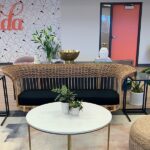Turns out it does, particularly when it comes to encouraging teamwork and collaboration.
Gretchen Anderson, director of interaction design at San Francisco agency Lunar Design, gave a presentation Wednesday night for members of the Computer-Human Interaction Forum of Oregon (CHIFOO) — a jovial audience of nearly 40 designers and architects gathering at the University of Oregon’s White Stag Block in Portland’s Old Town. Although the talk was clearly geared toward the design community — I’ll admit, she initially lost me on the “positive and negative space” concepts — Anderson offered up some qualities of good “war rooms” that businesses of any trade can establish.
BY KEVIN MANAHAN
So you’re setting up your team’s workspace. You can choose to go the cube farm route, or you can keep the space wide open (like our editorial department here at Oregon Business). You can even set up something temporary in a communal lunch area. Does the environment really make a difference?
Turns out it does, particularly when it comes to encouraging teamwork and collaboration.
Gretchen Anderson, director of interaction design at San Francisco agency Lunar Design, gave a presentation Wednesday night for members of the Computer-Human Interaction Forum of Oregon (CHIFOO) — a jovial audience of nearly 40 designers and architects gathering at the University of Oregon’s White Stag Block in Portland’s Old Town. Although the talk was clearly geared toward the design community — I’ll admit, she initially lost me on the “positive and negative space” concepts — Anderson offered up some qualities of good “war rooms” that businesses of any trade can establish.
One key practice is to set aside a workspace to be used specifically for collaborative work sessions. Open-floor setups typically aren’t conducive to collaboration because the inherent qualities of those spaces encourage people to walk through them rather than stay and work. “If [you’re in] banking, you still need to have a place where you’re thinking about what you’re going to do that’s different from your day-to-day operations,” Anderson said, adding that you should fill the space with things to inspire you to immerse yourself in that environment.
But not all companies have designated spaces for collaborative work sessions. What can you do instead? Conference rooms are a common substitute, of course, along with nomadic spaces that can be set up temporarily in any part of the office. And there’s the lunchroom example, a space that can be barricaded with makeshift items like bikes and can even be used as a team-building exercise during setup.
In addition, having a workspace where people can feel safe and secure with sharing their thoughts is essential. Anderson said that a space where you can vent about customer issues or even the faults of your own product will help you get to the truth of a situation. “Whatever it is, you’re not going to solve the problem by sticking your head in the sand, so you need a safe place to do that.” People should also feel at ease enough to just be messy. For designers, for example, the collaboration space is where they can freely play and work out issues (e.g. design problems) by trying things out.
A big no-no for Anderson is collaborating in virtual space. “It’s not collaboration,” Anderson said, not only because the physical presentation is missing, but also because it doesn’t give enough opportunity for back-and-forth dialogue. And although web cams are ideal for international collaboration, she said, you should still advocate for face-to-face meetings.
They’re all little things to consider, but they can add up in a big way for your team, and for the success of your product or service as a result of that improved collaboration. So go ahead and rearrange that office. I’m thinking of asking the boss to take the staff meetings to the conference room. I can only wear my headphones for so long.




